MV Kanimbla,
later the TSMV Oriental QueenTSMV Oriental Queen
Please Note: Firefox and some other search engines are not
suitable – Use “Internet
Explorer” for this page to load
perfectly!

Click the logo above to reach
the ssMaritime FrontPage for News Updates & “Ship of the Month”
With Reuben
Goossens
Maritime Historian, Cruise‘n’Ship
Reviewer, Author & Maritime Lecturer
Please Note: All
ssMaritime and other related maritime/cruise sites are 100% non-commercial and
privately owned. Be assured that I am NOT associated with any shipping or
cruise companies or any travel/cruise agencies or any other organisations!
Although the author has been in the passenger shipping industry since 1960,
although is now retired but having completed around
680 Classic Liners and Cargo-Passengers Ships features I trust these will continue
to provide classic ship enthusiasts the information the are seeking, but
above all a great deal of pleasure!
Reuben Goossens.
Australia’s Largest and
most Luxurious Coastal Liner
MV Kanimbla
HMS/HMAS
Kanimbla & later to become the Toyo Yusen’s TSMV Oriental Queen
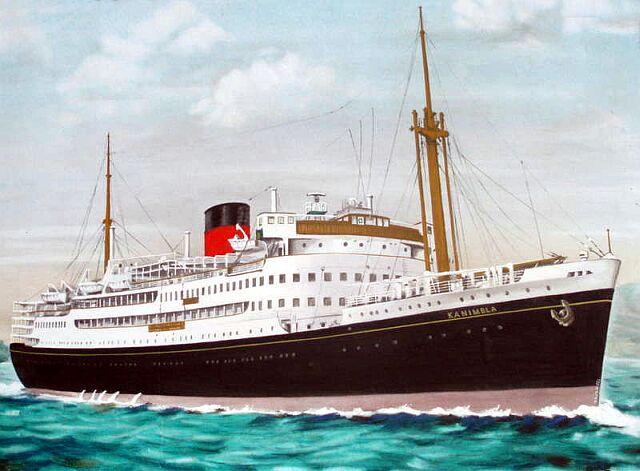
TSMV
Kanimbla was Australia’s
most beautiful and luxurious liner
The image
above is a copy taken from an original painting that hung in the Chief
Officer's dayroom.
What
happened to the original is not known. If anyone has any info we would love to
hear.
The well established
Australian coastal shipping company McIlwraith McEachern
Ltd was a company that originated in Scotland out of a company that
commenced on February 1, 1875 by Mr Andrew McIlwraith and Mr. Donald McEachern and at first the company was named the
“Scottish Line.” Soon they had eleven sailing ships that carried
migrants and cargo to the north of Australia,
especially Queensland.
The company proved to be very successful and soon they added a steamship the SS
Hero to their fleet. Both [partners frequently visited Australia and opened several offices in Queensland, then one in Sydney
and later in Melbourne.
With the trade having shifted from the Britain
migrant trade, they decided on the prosperous Australian coastal trade and in
the 1980’s they began to operate their steamships with their red and
black topped funnels along the Australian coast, covering Western
Australia to north Queensland.
Their early ships included Tagliaferro. Norkoowa, Eddystone. All carried
cargo, livestock and a few passengers. Eventually the passenger trade increased
and larger ships were obtained such as the 7,000-ton passenger liner SS Karoola in 1909. The next liner to be delivered was in 1913
was the 9,424-ton SS Katoomba, a larger version of her earlier sister and was
also was built by the Harland & Wolff. These two ships were the pride of
the McIlwraith McEachern fleet!
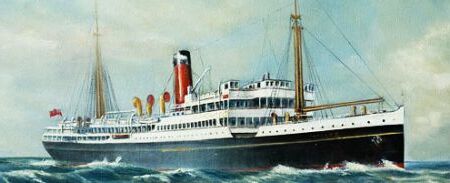
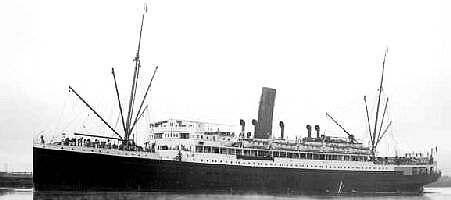
---
Above left: SS
Karoola, she was sold and scrapped in Japan in 1937
Above right: SS
Katoomba was sold in 1946 to Greece
to become the Columbia, sold and scrapped in Japan in 1959
As SS Karoola was
due to be retired in May 1936, McIlwraith McEachern
ordered a new and larger passenger liner again to be built by the ever reliable
Harland and Wolff Limited at Belfast in Northern Ireland.
She would be the last large passenger ship especially built for this Australian
ship owner. She was laid down in July 1933. Named Kanimbla she was launched by
Mrs. Jennings on 15 December 1935. She was completed on 26 April 1936 and ran
her trials several days later. The luxuriously appointed MS Kanimbla delivery
voyage to Australia was
quite unique, as she became the only Australian owned passenger liner to
transport migrants from Britain
to Australia
in style and comfort. MS Kanimbla arrived in Sydney
on June 10 and later that day she commenced her maiden coastal voyage to Melbourne, departing there on the 12th.and sailed for Adelaide and Fremantle.
Her regular service operated between Fremantle in Western Australia, Adelaide
in South Australia, Melbourne in Victoria, Sydney in New South Wales and
Brisbane, Mackay and Cairns in North Queensland. She partnered on the coastal
service with the company’s SS Katoomba until 1946, when she was sold, as
well as the Adelaide Steamship Company MS Manoora, sailing west in summer and
north in winter.
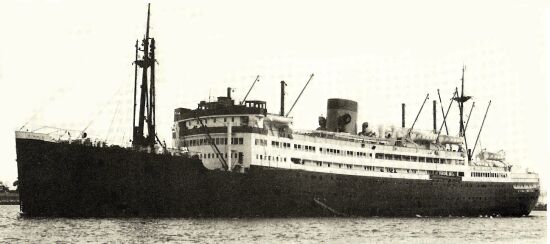
The
10,856 GRT MS Manoora was completed on February 6, 1935
However the MS Kanimbla was unique for so many
reasons, but the following beat them all: she just happened to be the only
passenger liner in history to have a fully operational radio broadcasting
station built into the ship at the time of construction. The equipment was
manufactured by AWA in Australia
and had been shipped to Ireland
for installation whilst the ship was still under construction.
Kanimbla had an extremely smart
and a modern looking profile for her day, her forward mast was raked a little
further aft than her aft main mast and she had a smart raked bow (yet a she had
traditional cruiser stern) giving her a streamlined look. She featured a
rounded forward glazed superstructure, which was a new innovation for an
Australian coastal ship.
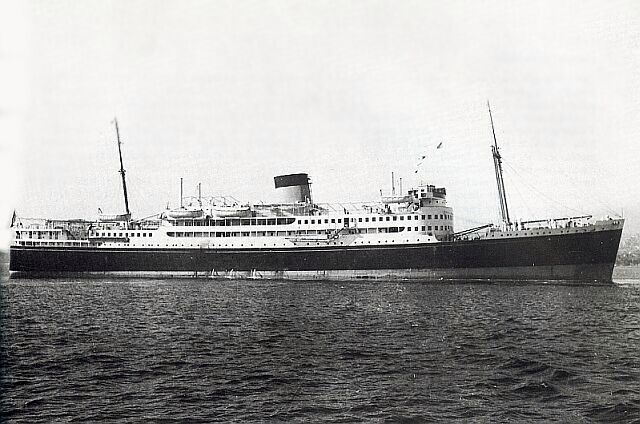
MS
Kanimbla was and remains Australia’s
pride and joy
Nothing was spared in fitting out the Kanimbla
featuring the most luxurious accommodation of any of the previous coastal
ships. She accommodated 203 passengers in First Class and 250 in Second Class.
Kanimbla proved to be a huge success with the Australian public as well as with
international visitors. Both classes had a fine range of lounges, dining rooms,
glazed promenades and shady deck spaces, as well as ample sport decks. Cabin
types varied from twin suites, to twin bedded rooms, two berth, and singles in
First class, although some cabins also had upper berths available for families,
these could be sold as three or four berth cabins. Second class was mostly
twin, two, three and four berth as well as some small dormitories, which were
suitable for an overnight voyage between “short hop” ports
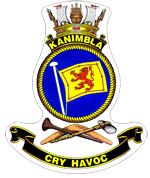
The
Kanimbla’s official shield
Specifications
…
Builders: Harland and Wolff Limited at Belfast in Ireland
Yard: 955
Launched; 15 December 1935
Tonnage: 10,985 GRT (Gross Registered
Tonnage)
Length: 147.6m / 484ft ft
Beam: 20.2m
/ 66.3ft
Draught: 6.8m
/ 22.2.
Engines: Burmeister
& Wain Geared Diesels
Screws: Twin - 10,000 BHP
Speed: 17 knots (Max 19)
Passenger
Decks: Six
Passengers: 202 First Class
250 Second Class
Crew: 190
War Time Duties:
She continued her varied schedules along the Australian
coast until the outbreak of World War II when the Australian Royal Navy who had
her refitted at Garden Island Dockyard, Sydney, requisitioned her on September
5, 1939. Armaments were fitted as follows. 7 x 6-inch guns.
2 x 3-inch anti-aircraft guns and 2 x Lewis light machine
guns.
She was officially commissioned
into the Royal Navy as Armed Merchant Cruiser and reregistered as the HMS
KANIMBLA on October 6, 1939.
Armed Merchant Cruisers were employed to
operate long ocean patrols looking out for enemy raiders and blockade-runners,
thus supplementing cruisers and allowing them to be released for the more
arduous fleet duties.
HMS Kanimbla departed Sydney on 13 December 1939 for Hong
Kong under the command of Commander Frank E. Getting RAN, with a complement
drawn almost entirely from the Royal Australian Navy, including Australian
reservists, having a total complement of 343.
She was Based in Hong Kong and
mostly stationed in the South China Sea. She
kept a constant patrol of the area and ensured that a good number of large
German Liners were stranded in Japanese ports, including the 18,000
ton Norddeutcher Lloyd Liner SS Scharnhorst.
They made several unsuccessful attempts to break
out.
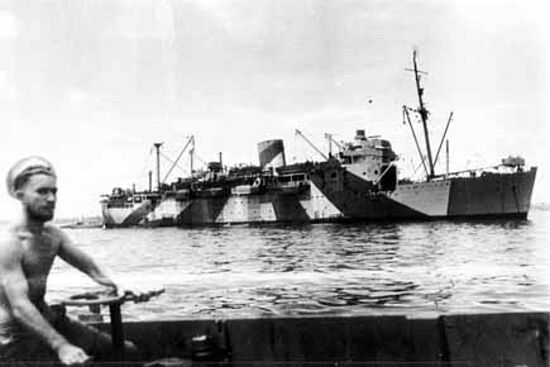
HMS
Kanimbla is seen in the South China Sea fully
camouflaged
In June 1940 the HMS Kanimbla was dispatched
to Singapore where she took patrol and escort duties around Malaya (Malaysia)
and the East Indies (Indonesia), eventually extending out into the Indian Ocean.
On the night of August 24, 1941
HMS Kanimbla, with 300 Indian troops on board led a flotilla in a surprise
attack on the Iranian port
of Bandar Shahpur
capturing eight German and Italian merchant vessels all containing valuable
cargoes, as well as two Iranian gunboats and a floating dock. Kanimbla went
alongside the burning Italian tanker Bronte and fought the fires while engaging
a train with her main armament and with her 3-inch guns. She remained in the
region until October 11, supervising the port and carrying out salvage work on
the captured vessels, including salvage work on the German freighter Hohenfels.
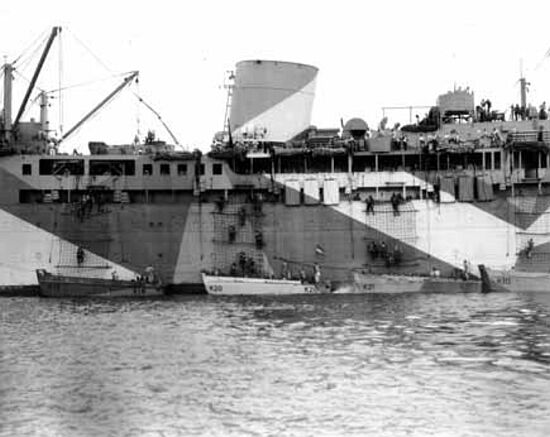
Wartime
activity in the China Sea
After
further work in Indian waters during the latter part of October and November,
Kanimbla proceeded to Singapore
and escorted the first convoy out of that city after the Japanese attack on Malaya. She arrived in Melbourne on Christmas Day. She carried out
further convoy work off the Australian coast and in both the Indian and the Pacific Oceans. On April 2 Kanimbla arrived in Sydney to be converted to a Landing Ship Infantry (LSI)
for operations in the Pacific and again in Asia.
The conversion involved the
removal of her 6-inch guns and the augmentation of her anti-aircraft armament
by the addition of a 4-inch gun and 2-pounder and 20mm close range weapons.
Radar was also added. She was fitted to carry 16 to 24 landing craft, which
were raised and lowered by davits fitted to either side of her superstructure.
Scrambling nets were fitted to enable troops to quickly enter the landing craft
after they had been lowered. Steel sheets replaced the ship’s interior
wood panelling and all available space was converted for the carriage of 1,280
troops although more were carried on various occasions.
On June 1, 1943 she was decommissioned
as the Landing Ship Infantry, and reregistered as the HMAS Kanimbla, and on
July 30 under the command of Commander N.H. Shaw RAN. HMAS Kanimbla recommenced
new duties in the Pacific and in Asia and she
continued to do her duties with great courage and completed each campaign with
great success!
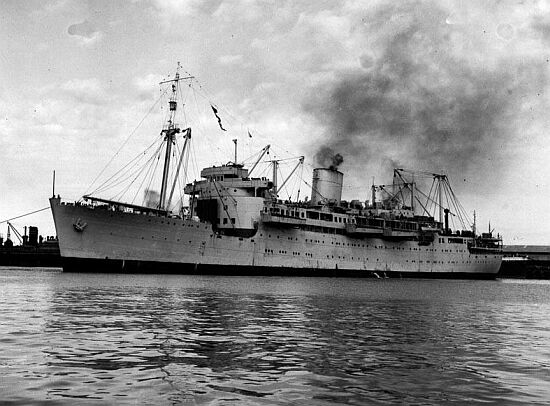
HMAS
Kanimbla is seen here in Fremantle in 1945
At
the end of the war HMAS Kanimbla was employed in repatriating Australian
servicemen from the Pacific Islands and also in returning Dutch dependents to the
East Indies (Indonesia).
Between October 1946 and June 1948 she sailed between Australia and Japan transporting British
Commonwealth Occupation Forces. During these voyages she was also required to
make calls to various Pacific
Islands to relocate
persons and cargoes. In 1948 Kanimbla was selected by the Royal Australian Navy
to head for the United
Kingdom to take personnel and stores in
order for them to commission the new HMAS Sydney, as well as returning with
British personnel who had enlisted in the Royal Australian Navy and 432
displaced persons.
Upon her return from the UK, she made one more voyage to Japan after which she was officially decommissioned
in Sydney on
March 25, 1949.
PS: Late in 2010 I received an email from a reader who advised me that
her “grandfather was in charge of the HMAS Kanimbla when the Japanese
mini subs attacked Sydney
Harbour.” His name
was Captain Fredrick Ross James, who later also commanded her having been sold
to become the MV Oriental Queen!
Post
War service:
The Australian Government paid for a
comprehensive refit of the war weary MS Kanimbla and having been all spruced up
and once again looking absolutely splendid and ready for service she was
officially returned to McIlwraith McEachern Ltd on
December 13, 1950.
There had been a good number of improvements
made, but also there had been a change of passenger capacities, which were now;
231 First Class and 125 Second Class for Coastal Liner services and 371 One
Class for Cruises. Also, MS Kanimbla was now registered as being 11,004 GRT.
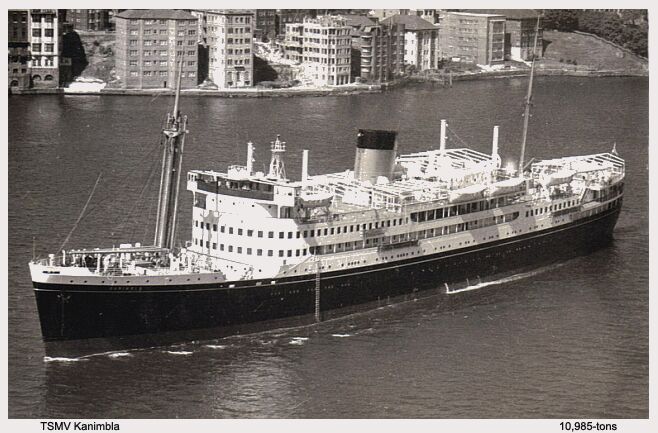
A
popular postcard of McIlwraith McEachern flagship MV
Kanimbla in Sydney
Harbour
During one of her coastal voyages I December
1960, Kanimbla ran aground on a sandbank in Moreton
Bay just out of Brisbane. She was soon refloated and taken to
Brisbane where
she was repaired.
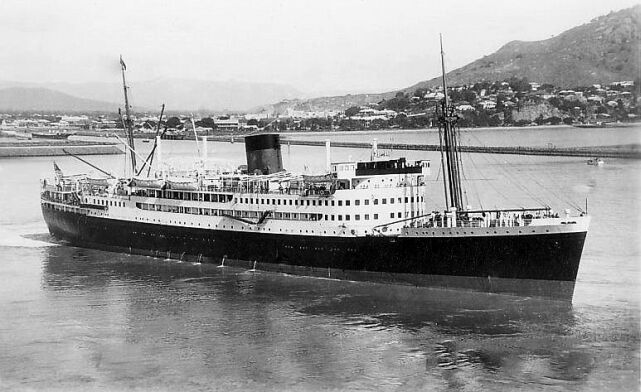
MV
Kanimbla looking superb!
Items of
Memorabilia
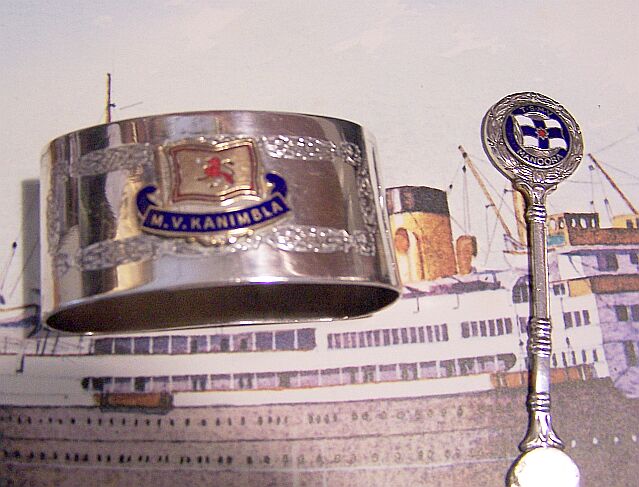
MV
Kanimbla Silver Serviette Ring and a TSMV Manoora Silver Cheese Knife seen on
an artist Impression of the Manoora
The
serviette ring and the cheese knife was kindly donated to the author by Holly Whillas
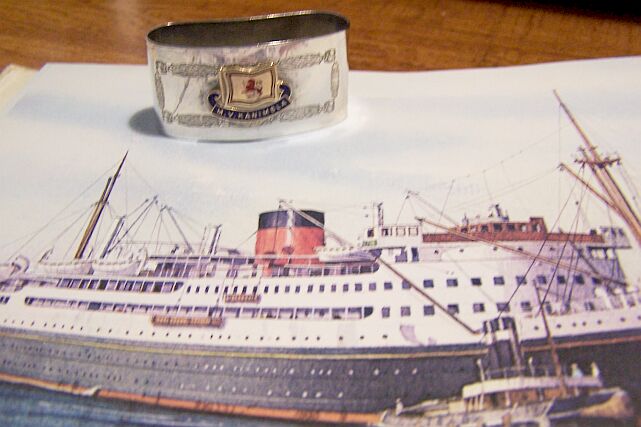
The
serviette ring is seen here in an artist impression of the MV Kanimbla
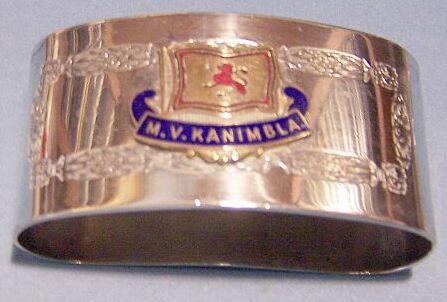
A
close up of the serviette ring
Sadly just like passenger shipping worldwide,
Kanimbla’s passenger loadings was suffering badly as airline trade was
beginning to become the main competition and airfares were becoming cheaper and
cheaper. Thus, the once booming coastal service began to suffer to the point
that tragically had to stop most of heir services, but McIlwraith McEachern decided to at least retain their flagship MV
Kanimbla on a part time basis operating on the coastal service, whilst also
operating cruises to Asia until 1961.
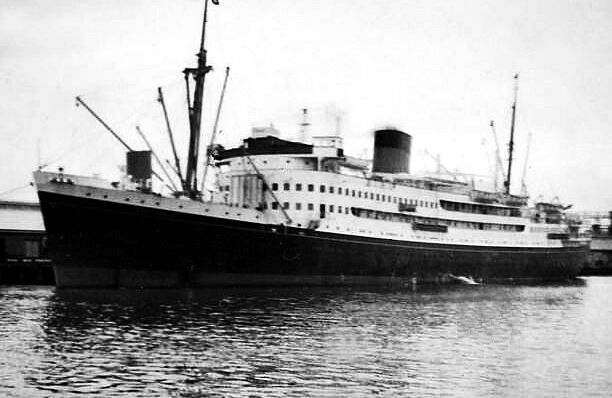
Kanimbla
seen during her final days as Australia’s greatest and most loved Liner
However, in 1960 she was placed on the market
and a Japanese Company purchased the best Australia liner ever to be built, our brloved MS Kanimbla always to be remembered as “Australia’s
finest coastal liner.”
TSMV
Oriental Queen:
In 1961 the ship was taken over by the Pacific
Transport Company and renamed TSMV Oriental Queen and registered in Panama. She
received a number of modifications and her hull was painted white, her funnel
was painted in bands of red, white and black, whilst her interiors were given a
more casual and tropical look.
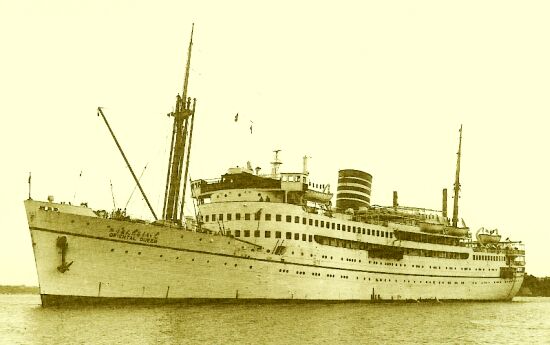
Oriental
Queen seen here whilst in operation as a Pilgrim ship
The
Indonesian Government who employed her for the next three years transporting
pilgrims from Indonesia
to Jeddah chartered her. Upon completion of the agreement in 1963 she was
chartered to an Australian company, Dover Pacific Cruises, and she operated
several Pacific Cruises during the summer of 1963/64, during which time her
funnel was to be painted green with a yellow “D” for Dover,
however, as Purser Peter Reynolds advised me, this never eventuated and the
red, white and black striped funnel remained.
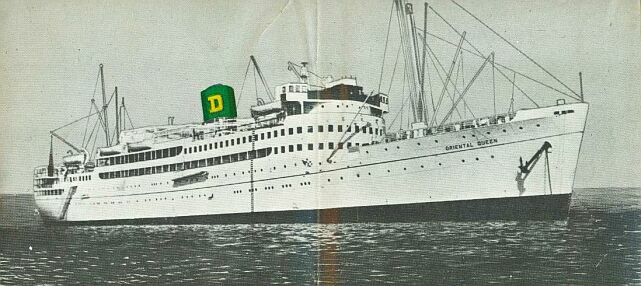
TSMV
Oriental Queen during her Australian season of Cruises for Dover Pacific Cruises
She
then returned to Japan
and Toyo Yusen K.K. a Japanese shipping company chartered her. She was now
registered thus flying the Japanese flag. Interestingly, Purser Peter Reynolds
was provided with a Japanese seaman’s card making him the only New
Zealander to hold one.
TSMV Oriental Queen began to
operate a programme of cruises between Australia,
New Zealand and Japan and during one stay in Yokohama
she was used as a floating hotel for Australian and New Zealand visitors to the 1964
Tokyo Olympic Games. Her accommodation now included 4 suites, as well as
single, twin, triple and four berth cabins.
TSMV Oriental Queen soon became
a popular sight in both New Zealand
and Australia and became a
popular means of crossing the Tasman Sea to and from Australia. As a cruise ship she
offered economical fares. Thus being a hit with both the younger and older
generations.
With her cruises so popular it
was decided to fit her with an outdoor pool and a Lido Deck, which enhanced her
even further as a cruise ship. She also operated a number of Pacific cruises
during 1965 and 1966. Oriental Queen was a regular visitor to both Auckland and Sydney.
In January 1967, Toyo Yusen decided to purchase the ship outright, however that
same month they also withdrew the once proud Australian ship from her homeland
forever.
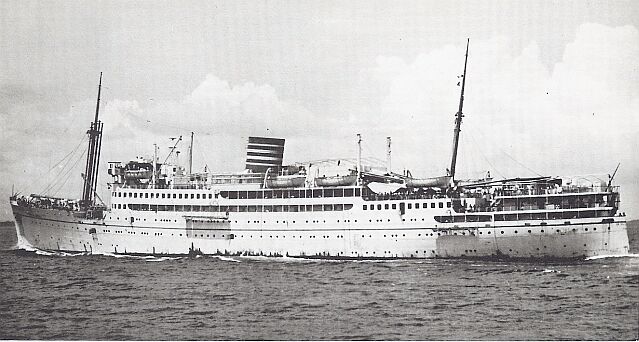
Upon
arrival from Auckland on January 13, 1967, she
sailed the following day for a one way Fly/Cruise
package to Hong Kong and Japan.
From there she operated from Yokohama to Guam
and was chartered in 1968 to operate 5 cruises to Honolulu
and Los Angeles.
Upon completion of the
Hawaii/USA charter, TSMV Oriental Queen resumed the Yokohama Guam service until
arriving back in Yokohama
on October 6 1973, which would prove to be her final voyage. She was laid up
and duly sold to Taiwanese breakers, arriving in Kaohsiung on December 7, 1973 to be broken
up. A proud Aussie served the seas for a good 37 years, and it is said;
although she was aging, she had a good heart!
MS
Kanimbla / Oriental Queen - Index
Page One
… The overall history of the
Kanimbla and Oriental Queen
Page Two … Oriental Queen images
and menu sent by a past Purser
Page
Three Stan Evans cruises
on the Oriental Queen - December 1965
Page
Four … Lorraine’s voyage
to the Commonwealth Games in 1964 on the Oriental Queen
Credits: Some of the wartime information was kindly provided by
Alain D. Waverton whilst two photographs are from an unknown source. The
“HMAS Kanimbla photograph at Perth”
is from the author’s collection and is no longer within copyright
restrictions. The photograph of the MS Oriental Queen seen
whilst under charter to Dover Pacific Cruises
Australia is from a brochure provided by the then purser Peter Reynolds. All
other photographs are from the author’s private collection.
A special thank
you to Keith Fry (Perth Australia) for
editing this article!
“Blue
Water Liners sailing to the distant shores.
I watched them come, I watched them go and I watched them die.”
****************************
Visit our ssMaritime
Main INDEX
Where you will discover around 680 Classic Passenger
& Passenger-Cargo Liners!
ssMaritime.com & ssMaritime.net
Where the ships of the past make history & the 1914 built MV Doulos Story
Please Note: ssmaritime
and associated sites are 100% non-commercial and the author does not seek
funding or favours and never have and never will.
Photographs on ssmaritime and associate pages are either by the author or from the author’s
private collection. In addition there are some images and photographs that have
been provided by Shipping Companies or private photographers or collectors.
Credit is given to all contributors, however, there are some photographs
provided to me without details regarding the photographer or owner concerned.
Therefore, I hereby invite if owners of these images would be so kind to make
them-selves known to me (my email address can be found at the bottom of the
page on www.ssmaritime.com), in order
that due credit may be given.
ssMaritime is owned & © Copyright by Reuben
Goossens - All Rights Reserved


















